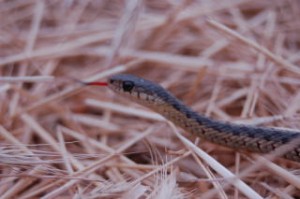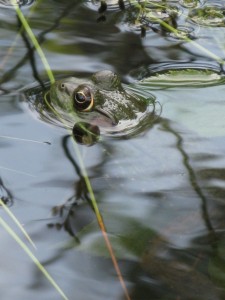Maybe the Princess was On to Something: A Gardener Falls in Love with Reptiles & Amphibians, Scales, Warts & All . . .
While I have certainly kissed my fair share of frogs in life, I can not say that any of them turned into princes. However I have never tried to kiss the warty, slimy amphibians residing in my garden, so it may be that they are the true royalty after all. And though I have always appreciated the beauty of a snake from afar, I am afraid I must be honest about my instinctive feelings toward those slithery creatures made famous by the Garden of Eden. Let’s just say we haven’t, historically speaking, been chums. But times change and people change, and sometimes it turns out that the creatures you find most repulsive can truly become your best friends.
 Eastern garter snake – Photo â“’ John Miller
Eastern garter snake – Photo â“’ John Miller
Take my new pal the garter snake for example. Mild mannered and rather shy, this helpful reptile is now a most welcome guest in my garden. Truth be told though, correcting my attitude toward the garter wasn’t exactly easy. Although it isn’t fair, we often pre-judge individuals by their kin, and the snake family and I have a somewhat checkered past. Our trouble began long-ago, in a childhood incident with a black rat snake. Playing in the backyard, I inadvertently stepped on or otherwise threatened this harmless creature and, in self-defense, it struck me with a painful bite. I no longer remember the details of this encounter, but apparently the bite mark on my arm frightened my parents enough to warrant a visit to the emergency room, where they were relieved to discover that the bite was non-poisonous. Perhaps if I had become a more sedentary, contemplative child, this would have been an isolated event. But no, this was not my destiny. As the years of my country-childhood went by, my arms and legs were punctured on various occasions by serpents, not that they were in any way to blame for our quarrels. I am afraid that on each and every instance, the snake was either stepped on or mishandled by yours truly. Eventually my curiosity turned to aversion, and from there it slid on down to genuine dislike. By the time I began gardening, I had come to loathe all snakes, (this attitude due to fear and ignorance on my part), and considered them my enemy.
Of course, not all snakes are as defenseless as those I have just mentioned. Some snakes have highly toxic venom, and they should be considered quite dangerous. In New England, where I garden, hike and play in the outdoors, poisonous snakes are virtually non-existent. The timber rattlesnake and the copperhead are the only two poisonous snakes living here, and they are considered rare or even endangered in some states. This is not true however, for other parts of North America or the world. Â In fact in some areas, poisonous snake populations are a serious threat to pets, small children and adults alike. If you live in an area with poisonous snakes, it is best to educate yourself about their preferred habitat and environment in order to deter their presence near your home. Â It is always a good idea to learn how to identify the creatures living around you, and respect their rightful place in the world.
The amphibian is another unsung garden hero. Unfortunately, many people are still repulsed by the thought of slimy pond-water filled with tadpoles and slippery frogs. While I have always liked salamanders, frogs and toads, I have only recently become interested in working on their PR campaign. Frogs, toads, salamanders, newts and their cousins are all excellent insect hunters. Some research claims that a single toad can consume over 100 insects per day!
Frogs are identified by their smooth, slippery skin, webbed feet, long hind-legs and bulging eyes. They like to live in and around water, where they lay clusters of eggs. Toads, conversely, have dry, warty skin, squat, stubby bodies, short hind-legs and glands between their eyes. Toads lay eggs in long chains in and around water. These two amphibious creatures are mainly carnivorous, and eat an extraordinary number of insects every day. In order to encourage their presence, some people like to place purchased toad-houses in their gardens, to provide these garden-friends with cool shelter from the sun and protection from predators. Toad shelters can also be created at home with old flower pots tipped to the side and concealed with twigs an branches, or naturally, with piles of stones and logs. Beware that toads can become ‘trapped’ inside houses without backdoors when pursued by snakes or other hunters. So, be sure to provide your warty friend with a second exit to the shelter. Frogs are most attracted to gardens with water features. Ponds and garden-pools are ideal for frogs of course, but even a sheltered water-bowl or dish will provide the moisture a frog needs. The same conditions attractive to frogs and toads are also pleasing to salamanders. As organic gardeners, the environment we provide is much safer and more hospitable to amphibians and reptiles than places where toxic pesticides and herbicides are used. Many of the chemicals in these products, as well fertilizer combinations used in inorganic lawn care, can kill amphibians, make them sterile or drive them off. A few minutes spent watching a frog capture mosquitoes should be enough to convince anyone to protect this garden prince from a toxic world.
Snakes and amphibians do not get particularly good PR rap in our culture. Its really up to all of us to change that. These days, when I see a child instinctively recoil from a reptile or amphibian, I think of my own experience and try to encourage a more positive, cautious curiosity. I like to point out that these animals will not harm us, (and in the case of snakes, will not strike unless we threaten them), and that they are helpful to us by eating the mosquitoes biting us and the slugs destroying our vegetable plants. The seeds of my irrational fears were sown in childhood, and it took many years of self-discipline and education to overcome my dislike of snakes. I would like to spare others from such a fearful relationship with any animal. While a fast moving serpent can still make me jump, (OK, perhaps even scream), I now quickly recover and laugh at myself as I return to my work in the garden. The snake may surprise me, but I know it is a natural helper and garden-friend.
 A Northern ribbon snake on my front terrace. Photo â“’ Michaela at TGE
A Northern ribbon snake on my front terrace. Photo â“’ Michaela at TGE
For help with identification, or for more information about snakes in New England, visit The Snake Lady of Rhode Island‘s website. For information about all North American reptiles, including snakes, turtles and more, visit the National Biological Information Infrastructure website. In addition, information and help with identifying snakes in North America may be found by visiting the excellent snake identification webpage developed by Doug Henderson and Dennis Paulson for the Slater Museum of Natural History.
For more information on amphibians, such as the frogs, toads and salamanders of North America, visit the USGS Northern Prairie Wildlife Research Center’s Checklist of Amphibian Species and Identification Guide.
***
1st garter snake photo copyright Diane and John Miller, courtesy of The Old Schoolhouse Plantery
All other photos and article copyright 2009 Michaela at The Gardener’s Eden
***
All content on this site, (with noted exceptions), is the property of The Gardener’s Eden and may not be used or reproduced without prior written consent. Inspired by something you see here? Great! Please give credit where credit is due. It’s a small world and link-love makes for fond friendships. Stealing makes for bad dreams…
Do you enjoy visiting The Gardener’s Eden? You can help support this site by shopping through our affiliate links. A small percentage of any sale originating from The Gardener’s Eden site will go toward web hosting and maintenance costs. Thank you for your support!
***



2 Replies to “Maybe the Princess was On to Something: A Gardener Falls in Love with Reptiles & Amphibians, Scales, Warts & All . . .”
Comments are closed.